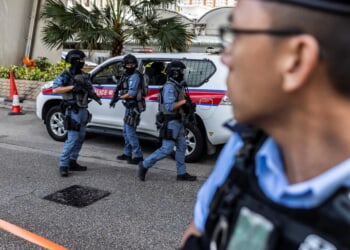Lord Ashcroft KCMG PC is an international businessman, philanthropist, author and pollster. For more information on his work, visit lordashcroft.com.
This week marked the expiration of Donald Trump’s fourth two-week deadline for Vladimir Putin to start meaningful peace negotiation over Ukraine. Yet we have no sign of movement from the Kremlin, nor any retaliation from Washington. Instead, Putin confidently embarked on an unprecedented four-day visit to China, attending the Shanghai Cooperation Organisation summit.
His red-carpet welcome in Beijing – the second in as many weeks – confirmed what many feared ahead of the Alaska Summit: that Trump’s efforts to halt the Russo-Ukrainian war through diplomacy have only legitimised Putin on the international stage.
The most striking image was Putin strolling hand-in-hand with Narendra Modi, the Indian prime minister. India, once groomed by Washington as its foremost ally and counterweight to China in Asia, now finds itself facing sweeping tariffs of 50 per cent and a bewilderingly hostile reception from once a close friend.
Putin, meanwhile, shows no signs of bowing to the US ultimata. Instead, he deepens ties with his principal backer in this war – China. Xi Jinping greeted him as “an old friend” and signed new agreements, including on expanded gas supplies. With Russia and China planning another major pipeline, the relationship (and China’s support for Russia’s war effort in Ukraine) is accelerating, not slowing.
This week’s pageantry underscored that shift. China’s own Victory Day parade – the one we are used to seeing in Moscow – is casting China as the key victor against Japan in Asia. It symbolises the continued weaponisation of the past, as much as the unification of an alliance openly adversarial to the West in the present.
Meanwhile the Shanghai Cooperation Organisation, once a forum to combat cross-border crime, has been turned into a geopolitical lever. Its summit drew not only its ten member states, including Russia and Iran, but delegations from 26 countries – all aligned with the idea of an alternative to the transatlantic post-WW2 order.
North Korea’s Kim Jong Un joined as well, reinforcing the sense of a new “Axis of Upheaval”. Pyongyang, according to Ukrainian intelligence, is preparing to send 30,000 troops to Ukraine, but is also expanding its nuclear arsenal aimed squarely at the United States.
All this comes amid continued US retreat from the international stage and the alienation of its key allies. Will this be acknowledged in the White House? And will Congress, reconvening this week, finally act to curb Putin’s growing impunity by enforcing harsh sanctions on Russia?
Whatever America decides, Europe must recognise a new reality: on Ukraine, it’s on its own. Flattery towards Trump or delaying the US withdrawal from Europe’s security provision cannot mask the fact that Washington has repeatedly said it does not see the Ukraine war as its problem
The consequences of that stance for America’s own security deserve a separate discussion. But for now, one truth is inescapable: Europe must assume full responsibility for providing Ukraine with timely, sustainable military support, and demonstrate real resolve by seizing frozen Russian assets. Until such measures are taken, talk of peacekeeping configurations is meaningless, for peace remains distant.
Much has been said about Western security guarantees for Ukraine. America has relegated the lead role to Europe, offering only intelligence support and weapons sales to European states, who in turn will supply them to Kyiv. The latter primarily benefits US defence companies, while the former can be withdrawn as abruptly as it is granted.
We have seen it before. From where we stand today, the United States risks providing weaker security guarantees in 2025 than those Ukraine received under the infamous Budapest memorandum in 1994.
Meanwhile, Russia almost sarcastically insists that no security arrangement for Ukraine can be complete without China’s participation – the very country propping up Moscow’s war machine through oil and gas revenues and the dual-use technology. The only step more absurd would be to invite North Korea to serve as a mediator.
While this tragi-comic spectacle unfolds, one reality is stark: the liberal coalition that secured peace after World War II is no longer fit for purpose. Its inadequacy not only costs Ukrainian lives but emboldens our adversaries, risking catastrophe on a global scale.
Anyone who thinks Putin is preparing to abandon his aggression, be it in 24 hours or two weeks, should think again. He feels strengthened by America’s lack of resolve, Europe’s hesitation, and the backing of allies such as China, Iran and North Korea.
On 1 September, as Russian students returned to school, they were presented with 32 new classes on “patriotism”. If that is not a signal that Russia is preparing its next generation for a long confrontation with the West – if not an outright war – then what is?





![Gavin Newsom Threatens to 'Punch These Sons of B*thces in the Mouth' [WATCH]](https://www.right2024.com/wp-content/uploads/2025/08/Gavin-Newsom-Threatens-to-Punch-These-Sons-of-Bthces-in-350x250.jpg)
![ICE Arrests Illegal Alien Influencer During Her Livestream in Los Angeles: ‘You Bet We Did’ [WATCH]](https://www.right2024.com/wp-content/uploads/2025/08/ICE-Arrests-Illegal-Alien-Influencer-During-Her-Livestream-in-Los-350x250.jpg)

![Black BET Billionaire Donor Stuns Democrats, Gives $500K to Winsome Earle-Sears [WATCH]](https://www.right2024.com/wp-content/uploads/2025/08/Black-BET-Billionaire-Donor-Stuns-Democrats-Gives-500K-to-Winsome-350x250.jpg)






